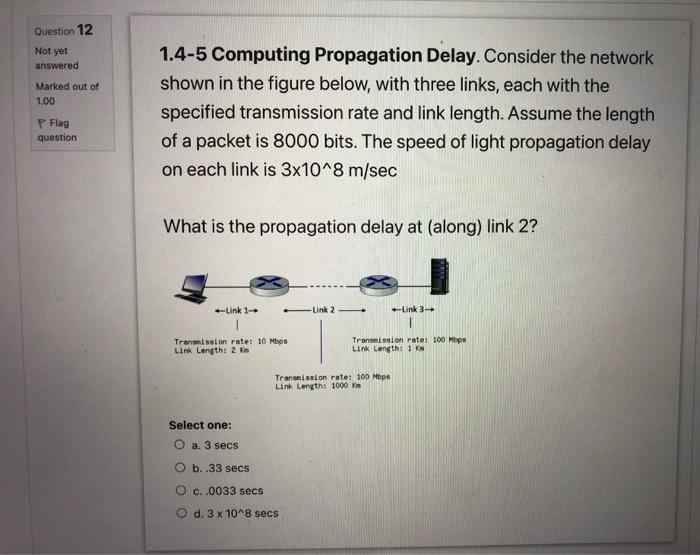Question 11 Not yet answered Marked out of 100 1.4-4 Computing Packet Transmission Delay (3). Consider the network shown in the figure below, with three links, each with the specified transmission rate and link length. Assume the length of a packet is 8000 bits. Flag question What is the transmission delay at link 2? [Note: you can find more problems like this one here.] Link 2 Transmission rate: 10 Mbps Link Length 2 KM Transion rate 100 Mops Link Length: Transmission rate 100 Mbps Link Length 1000 W Select one: O a. 12,500 secs O b.8 x 10^(-5) secs O c..00096 secs d. 100 secs e. 12.5 secs Question 12 Not yet answered Marked out of 1.00 1.4-5 Computing Propagation Delay. Consider the network shown in the figure below, with three links, each with the specified transmission rate and link length. Assume the length of a packet is 8000 bits. The speed of light propagation delay on each link is 3x10^8 m/sec P Flag question What is the propagation delay at (along) link 2? Link 1- -Link 2 - Link 3+ Transmission rate: 10 Mbps Link Length: 2 km Transmission rate: 300 Mbps Link Length: 1 Transmission rate: 100 Mbps Link Length 1000 m Select one: O a. 3 secs O b..33 secs O c..0033 secs O d. 3 x 10^8 secs Question 13 Not yet answered 1 Marked out of 1.00 1.3-7 Packet switching or Circuit-switching? Consider a scenario in which 5 users are being multiplexed over a channel of 10 Mbps. Under the various scenarios below, match the scenario to whether circuit switching or packet switching is better. P Flag question 13 19 Each user generates traffic at an average rate of 15 Mbps, generating traffic at rate of 1 Mbps when transmitting Fini Choose... Tim Each user generates traffic at an average rate of 1.2 Mbps, but generates traffic at rate of 15 Mbps when transmitting Choose... e Each user generates traffic at an average rate of 1 Mbps, generating traffic at rate of 1 Mbps when transmitting Choose... Question 11 Not yet answered Marked out of 100 1.4-4 Computing Packet Transmission Delay (3). Consider the network shown in the figure below, with three links, each with the specified transmission rate and link length. Assume the length of a packet is 8000 bits. Flag question What is the transmission delay at link 2? [Note: you can find more problems like this one here.] Link 2 Transmission rate: 10 Mbps Link Length 2 KM Transion rate 100 Mops Link Length: Transmission rate 100 Mbps Link Length 1000 W Select one: O a. 12,500 secs O b.8 x 10^(-5) secs O c..00096 secs d. 100 secs e. 12.5 secs Question 12 Not yet answered Marked out of 1.00 1.4-5 Computing Propagation Delay. Consider the network shown in the figure below, with three links, each with the specified transmission rate and link length. Assume the length of a packet is 8000 bits. The speed of light propagation delay on each link is 3x10^8 m/sec P Flag question What is the propagation delay at (along) link 2? Link 1- -Link 2 - Link 3+ Transmission rate: 10 Mbps Link Length: 2 km Transmission rate: 300 Mbps Link Length: 1 Transmission rate: 100 Mbps Link Length 1000 m Select one: O a. 3 secs O b..33 secs O c..0033 secs O d. 3 x 10^8 secs Question 13 Not yet answered 1 Marked out of 1.00 1.3-7 Packet switching or Circuit-switching? Consider a scenario in which 5 users are being multiplexed over a channel of 10 Mbps. Under the various scenarios below, match the scenario to whether circuit switching or packet switching is better. P Flag question 13 19 Each user generates traffic at an average rate of 15 Mbps, generating traffic at rate of 1 Mbps when transmitting Fini Choose... Tim Each user generates traffic at an average rate of 1.2 Mbps, but generates traffic at rate of 15 Mbps when transmitting Choose... e Each user generates traffic at an average rate of 1 Mbps, generating traffic at rate of 1 Mbps when transmitting Choose









